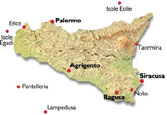 |
 |
|
Gela (CL) | ||
|
||||||||
|
Widely touted today as the most unpleasant city in Sicily: I can only confirm that visually and aesthetically this is indeed the case. My diary from 1993 notes "Gela must have been a most beautiful place once - the situation just above the long sandy beach would have been breath-taking. But the single remaining Doric column of the Temple of Athena is echoed now by the red and white chequered chimney of the adjacent oil refinery. The whole town smells of oil. The outskirts are utterly hideous with vast quantities of litter blowing across unfinished or un-started building sites. The Gela river, from which the Greek city took its name, is a polluted drain ..." But it's still essential visiting for two reasons.
Next to the Museum are the remains of the Acropolis - including the single standing column from the Temple of Athena. As at Megara Hyblaea, the modern world has encroached as closely as it can upon the ancient. Etna is just visible from here on a clear day. The second reason is at Capo Soprano to the west of the city - the Muri Greci (Greek Walls) which were uncovered in 1953 from the sand-dunes that had swamped and then preserved them - Daphne was there. They are quite remarkably well- preserved. The stone blocks at the base look as sharp and well pointed as if they were laid yesterday - the mud brick ones which raised the walls to a height of 8 to 13 metres are preserved under plastic. They date from Timoleon's revival of the city in 338 BC - this was short-lived, as it fell to Agathocles in 311 BC, when 4,000 Geloans were massacred. The survivors were moved a few years later by Phintias of Akragas to make up the numbers of his new eponymous foundation along the coast at Phintias (now Licata). The empty site was finally destroyed by the Mamertines - by this time Timoleon's beautiful walls had long been reclaimed by the sand, awaiting the excitement of their rediscovery in the 20th century.
Near the walls are the remains of some Hellenistic baths - also worth a visit. As a antidote to Gela, I drove to the Lago di Biviere, a few kilometres to he east and anjoyed a peaceful picnic lunch watching marsh harriers, hoopoes and egrets. This is now one of seven nature reserves administered by the Province of Caltanissetta.
|
 |
Use the table below to find your way around Sicily: |  |
||||||||||
| Map | Index | PA | ME | CT | EN | CL | SR | RG | AG | TP | ||
Printer friendly page: click to print
| What's new? | Search the site? | Main Index? | Bookshop? | Top of Page? | ||||
|
The Classics Pages are written and designed
by Comments, questions and contributions welcome. |
||||||||